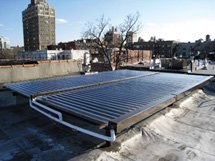HABITAT
Co-op Solar Thermal Park Slope Brooklyn
Sept. 22, 2011 — Richard Cherry is president of the Community Environmental Center, and Richard Klein is founder and CEO of Quixotic Systems Inc.
Suddenly, solar thermal is hot. A cutting-edge approach to heating water for showers, dishwashers, laundry machines and more, it's at the forefront of renewable energy and can also reduce a building's fuel costs. One co-op in Brooklyn's Park Slope neighborhood has installed a version of solar thermal, and serves as a case study of what it is, how it works and whether it's right for your co-op or condo building.
There are two related technologies: A solar thermal system uses the sun's energy primarily to create heat. A photovoltaic (PV) system uses solar energy to produce electricity. In a solar thermal system, solar panels — either flat-plate collectors or evacuated tubes (see image above) — are installed on a roof. A flat-plate collector contains tubes filled with propylene glycol (antifreeze), which absorbs and holds the sun's heat. The vacuum-tube design is made up of long cylinders. The vacuum acts as a perfect insulator in very cold weather: Inside the vacuum, sunlight is converted to heat, which is then transferred to a standard piping system that runs glycol.
In each case, heated glycol travels along pipes to a water-storage tank (usually in a building's basement) and heats potable water, which then travels through the building's pipes to residents' apartments.
Will It Work Here?
One myth holds that solar thermal can't work in a Northeastern city known for its temperate climate. But the reality, as Canada and northern European countries have demonstrated, is that a solar thermal system can collect and store the sun's energy year-round, although obviously the sun's heat will be more available during spring and summer. At other times of the year, a building's conventional water-heating system can kick in if necessary.
And considering that 30 percent of a building's energy is used to heat water, if a solar thermal system can offset that by 50 percent, then you have a 15 percent reduction in the total energy for a building. That's a considerable reduction, in terms of both fossil-fuel emission and cost. A well-designed system can last 20 to 30 years, although the glycol probably needs to be changed after seven years. Solar panel manufacturers usually have warranties of 10 to 15 years.
30 percent of a building's energy
is used to heat water. If solar thermal
offsets that by 50 percent, you have
a 15 percent energy reduction.
Quixotic Systems is a Manhattan-based company that designs both thermal and PV solar systems. It was one of the first eligible installers in New York State as well as one of the first New York State NABCEP (North American Board Certified Energy Practitioners) installers. The Community Environmental Center (CEC) is a Queens-based nonprofit, founded in 1994 to bring energy efficiency and green solutions to new and existing buildings. CEC is licensed by the New York State Energy Research and Development Authority (NYSERDA) to install solar thermal systems in New York State.
Over the past year, our two firms have partnered to integrate solar thermal systems in a variety of New York City buildings. Based on our experience, we have concluded that, in New York City, the optimal residential building for a solar thermal system would be six to eight stories and have 2,000 or more square feet of usable roof space. Certainly, solar thermal systems can be designed for taller buildings — and have been. But one of the requirements of almost any system includes installing a large pipe that runs from the collectors on the roof to the water storage tanks in the basement, and the more piping, the bigger the investment in materials and labor.
Of course, for any co-op or condo a solar thermal system is a substantial investment. But a federal tax credit is available to assist with upfront costs (and in 2011 only, a federal tax grant, which means a check in the mail). It mostly benefits buildings that include commercial businesses, but under certain conditions, co-op and condo buildings can qualify.
Solar in Park Slope
One co-op that's installed such a system is the small building at 176 Sterling Place in Park Slope, Brooklyn. It has four floors plus a basement, and 12 units, a few of which are duplexes. Built in 1906, it went co-op in 1985. The co-op board's treasurer, Robert Dascoli, proposed the idea of installing both solar thermal and solar PV — a hybrid system.
"Our board president tries to be very green," says Dascoli. "But also, it was 2007, and energy costs were absolutely soaring. Our water bills were going up 15 percent each year, and our Con Ed rate was also going up. National Grid, our gas purveyor, seemed to raise their rates, and the dryers in our basement use gas. We were looking for alternative energy routes."




